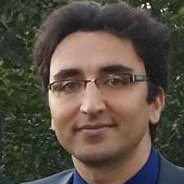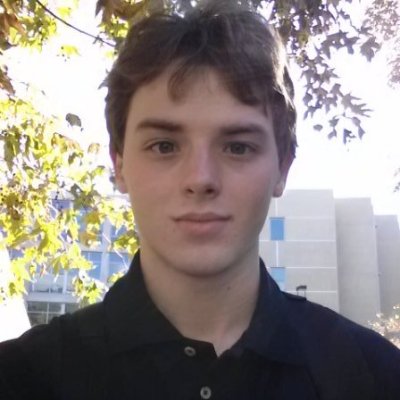
At least 72 posters will be on display when UC San Diego students share their research results during two poster sessions during the Frontiers of Innovation Scholarship Program (FISP) Symposium on Tuesday, October 18 in the Price Center. (Click link at bottom to read a preview of oral presentations at the symposium.) Hour-long poster sessions are scheduled to start at 12:30pm and 4:45pm, respectively, in Price Center Ballroom A. Posters are only on view during one session not both. (Consult the FISP program for details.)
 The presenters will include CSE fourth-year Ph.D. student Mohsen Malmir (right), who will present "Music Generation by Deep Recurrent Neural Networks." He was mentored by CSE Prof. Gary Cottrell and Music Prof. Shlomo Dubnov. Malmir developed algorithms that learn to generate new music by learning from annotated music. The student trained "deep recursive neural networks (DRNNs) to generate sequences of tones along with their temporal information," says Malmir, adding that he aimed to "analyze the structure of the trained network and the learned sequences to find relations with higher level structures in music." Subsequent to the project, Malmir proposes to make the music dataset and relevant codes available to the research community for further development.
The presenters will include CSE fourth-year Ph.D. student Mohsen Malmir (right), who will present "Music Generation by Deep Recurrent Neural Networks." He was mentored by CSE Prof. Gary Cottrell and Music Prof. Shlomo Dubnov. Malmir developed algorithms that learn to generate new music by learning from annotated music. The student trained "deep recursive neural networks (DRNNs) to generate sequences of tones along with their temporal information," says Malmir, adding that he aimed to "analyze the structure of the trained network and the learned sequences to find relations with higher level structures in music." Subsequent to the project, Malmir proposes to make the music dataset and relevant codes available to the research community for further development.
 CSE computer science junior Allan Yeh (left) will present a poster on "Interacting with Chemical Software." Yeh has been developing a molecular database in which new molecules can be uploaded for users to download and use in their own molecular simulations. Says Yeh: "The FISP scholarship has helped give me a better understanding of how my knowledge of computer science can be applied to the world at large."
CSE computer science junior Allan Yeh (left) will present a poster on "Interacting with Chemical Software." Yeh has been developing a molecular database in which new molecules can be uploaded for users to download and use in their own molecular simulations. Says Yeh: "The FISP scholarship has helped give me a better understanding of how my knowledge of computer science can be applied to the world at large."
Structural Engineering professor and CSE faculty-affiliate Falko Kuester mentored multiple poster presenters and speakers from different majors, including electrical and computer engineering as well as visual arts.
 ECE senior and Qualcomm Institute intern Dimitri Schreiber (right) will present a poster on "CAVECamX: Autonomous Stereo Spherical Panorama System." CAVECamX is a small, binocular, two-axis gimbal system used for creating high-resolution 3D photospheres, combined with GPS and inertial measurement unit (IMU) data, enabling better coregistration internally within a single photosphere, and externally between heterogeneous datasets, including fusion with point clouds generated from photogrammetry and LIDAR" laser scanning. "This decreases human processing time by automatically recording location and orientation of the dataset, which would previously be recorded manually and therefore likely left out or lost," says Schreiber. "The attitude data will help fully automatic stitching of stereoscopic datasets without the commonly associated motion sickness by constraining the system." Noting that CAVECamX is small and consumes little energy, the student adds that it "enables remote visualization of archaeological sites, allowing researchers to be virtually immersed in the captured scene without having to travel across the globe."
ECE senior and Qualcomm Institute intern Dimitri Schreiber (right) will present a poster on "CAVECamX: Autonomous Stereo Spherical Panorama System." CAVECamX is a small, binocular, two-axis gimbal system used for creating high-resolution 3D photospheres, combined with GPS and inertial measurement unit (IMU) data, enabling better coregistration internally within a single photosphere, and externally between heterogeneous datasets, including fusion with point clouds generated from photogrammetry and LIDAR" laser scanning. "This decreases human processing time by automatically recording location and orientation of the dataset, which would previously be recorded manually and therefore likely left out or lost," says Schreiber. "The attitude data will help fully automatic stitching of stereoscopic datasets without the commonly associated motion sickness by constraining the system." Noting that CAVECamX is small and consumes little energy, the student adds that it "enables remote visualization of archaeological sites, allowing researchers to be virtually immersed in the captured scene without having to travel across the globe."
Kuester also mentored two Visual Arts majors -- Samuel Balatbat (below left), and Bertha Yue (below right) -- both working on 3D visualization projects involving the Chaco canyon archaeological site in New Mexico.
 Balatbat's project, "Stereoscopic Photospheres of the Historical Site of Chaco in New Mexico," involves stereoscopic photospheres, i.e., pairs of images captured by either a CAVEcam or CAVECamX. "These images have full 360-degree depth coverage, making it possible for archaeologists and viewers to be virtually present at sites," according to Balatbat's abstract. The visualization can happen through either head-mounted displays (such as the Oculus Rift or HTC Vive) or through the Qualcomm Institute's large-scale CAVE display systems (WAVE, StarCAVE, NexCAVE, etc.). Balatbat will showcase some of the stereoscopic photospheres captured at the Chaco site and processed for 3D viewing.
Balatbat's project, "Stereoscopic Photospheres of the Historical Site of Chaco in New Mexico," involves stereoscopic photospheres, i.e., pairs of images captured by either a CAVEcam or CAVECamX. "These images have full 360-degree depth coverage, making it possible for archaeologists and viewers to be virtually present at sites," according to Balatbat's abstract. The visualization can happen through either head-mounted displays (such as the Oculus Rift or HTC Vive) or through the Qualcomm Institute's large-scale CAVE display systems (WAVE, StarCAVE, NexCAVE, etc.). Balatbat will showcase some of the stereoscopic photospheres captured at the Chaco site and processed for 3D viewing.
Bertha Yue's research also focused on the New Mexico site. Her poster will explore "Using Photogrammetry to Create a 3D Model of the Chaco Pueblos in the American Southwest." (Her research abstract was deleted from the FISP Symposium program "owing to proprietary information.")
Read more about oral presentations on the FISP Symposium agenda.
Download the complete program with abstracts for all FISP Symposium 2016 presentations.

